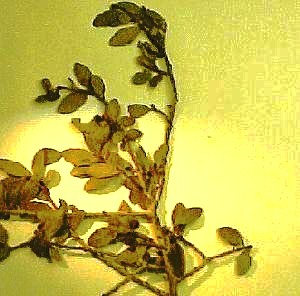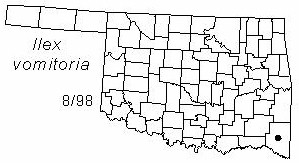
Evergreen shrub or rarely small tree to 5 m (15 ft) tall. Bark thin, scaly, reddish-brown. Twigs slender, hairy when young, becoming rough, with numerous spur shoots. Leaves alternate, evergreen, elliptical, 2-3 cm (0.8-1.2 in) long and 6-13 (0.3-0.5 in) mm wide, blunt-pointed, rounded at base, finely wavy-toothed, thick, stiff, shiny green and glabrous above, paler below. Flowers dioecious, small, 4-petaled, clustered at base of old leaves in early Spring. Fruits numerous red drupes about 6 mm (0.25 in) in diameter, with 4 grooved nutlets, clustered along twigs, ripening in late Summer and persisting into the Winter.
Distribution: The species is native to the coastal plain from Virginia to Mexico.
Habitat in Oklahoma: near streams in the southeastern corner of the state.
NWI status: FAC-
Comment: The fruits are eaten by several species of birds. Ilex is the ancient name of the European holly oak; vomitoria refers to its medicinal use as an emetic.
Distribution in Oklahoma: Rare and local in McCurtain County. Seems to be most abundant in Beavers Bend State Park. 
BACK
NEXT
RETURN TO INDEX
Last update: 9/10/99
 Go to Oklahoma Biological Survey Home Page
Go to Oklahoma Biological Survey Home Page
 Disclaimer
Disclaimer